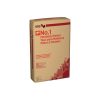Sign In
You're All Set
Welcome back! You are now signed in.
You have been logged out
You have been logged out due to inactivity
Forgot Password
Please enter the email address you used to create the account. We'll send you a link that lets you create a new password.
You're All Set
Please check your email. Click the link in the email to create a new password.
Reset Password
You're All Set
Success! Your password has been updated.
Change Password
You're All Set
Success! Your password has been updated.




No. 1 Moulding Plaster
Ornamental plaster used for creating decorative trim or running cornices.
Key Documents & Design Files
Overview
Overview
Main Features
Often referred to as Plaster of Paris or soft plaster, No. 1 Moulding Plaster is used to create waste molds or temporary patterns where surface hardness and strength are not crucial.No. 1 Moulding Plaster:- Offers a controlled set that provides uniform workability
- Has a fine grain — making it ideal for producing sharp detail when used neat for cast work
- Complies with ASTM C28
- Sets in 27-37 minutes after mixing
- Requires 70 parts water by weight per 100 parts plaster
- Is available in 50- and 100-pound bags
Documents & Files
Data Sheets & Specifications
| Data/Submittal Sheet (English) | PDF 233.3 KB |
Catalogs & Brochures
| System Catalog (English) | PDF 18.5 MB |
| Brochure (English) | PDF 3.5 MB |
Installation & Technical Manuals
| Installation Guide (English) |
SDS, Certifications & Reports
| SDS (English) | PDF 637.1 KB |
| Certificates (English) | PDF 158.1 KB |
Ask a question
Our customer support team will get back to you as soon as possible.
Question Guidlines
- Questions should relate to this product specifically.
- For help with pricing, availability, or delivery, please call 800.874.4968 (Monday–Friday, 7am–6pm Central)
- All questions and answers follow USG’s Terms & Conditions.
- Your question and USG’s answer may be posted to this page in the future, but none of your personal info will be included.
q & a
-
How do I mix plaster?
You will need a bucket, scale and mixing equipment. Mixing could be accomplished through basic hand mixing with a large spoon, but mechanical mixing is preferred. An electric drill with a cage mixer head attached is good for small batches.
The first step involves measuring and adding enough water to the bucket to achieve the desired consistency. You then need to weigh out enough gypsum plaster to meet the proper ratio for the selected water volume. Sift the plaster into the bucket of water and allow the plaster to soak for 1 to 2 minutes. Follow this immediately with mixing, generally for 1 to 2 minutes based on product.
NOTE: If mixing by hand, use vigorous stirring action. After mixing and pouring the gypsum slurry, make sure to clean all tools and the mixing vessel before the plaster hardens.
For more detail on mixing, see USG publication IG503, Plaster Mixing Procedures.
-
Have a question?
Ask USGLet us do the research. We'll get back to you as quickly as we can.
-
Need help right away?
Call our Technical Support team at 800-874-4968 (Monday-Friday, 7:30 am - 4 pm Central).



